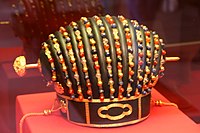| King of Ryūkyū | |
|---|---|
| 琉球国王 | |
 Royal Crest | |
 Crown of the King of Ryūkyū | |
| Details | |
| Style | Your Majesty (主上, 王上, 聖上) Ushū (御主) Miomae-ganashi (美御前加那志 nmee ganashii, used by royal family) Shūri-ten-ganashi (首里天加那志 shu-i tin ganashii, used in Okinawa Island) Uchinaa-ganashi (沖縄加那志, used in outlying islands) |
| First monarch | Shunten (traditional narrative) |
| Last monarch | Shō Tai |
| Formation | 1187 (traditional date) |
| Abolition | March 17, 1879 |
| Residence | Shuri Castle |
| Pretender(s) | Mamoru Shō |
King of Ryūkyū[1][2] (琉球国王[3][4][5][6], Ryūkyū koku-ō), also known as King of Lew Chew,[7] King of Chūzan (中山王[8][9], Chūzan-ō), or more officially Ryūkyū Kingdom's King of Chūzan (琉球国中山王[8], Ryūkyū-koku Chūzan-ō), was a title held by several lineages from Okinawa Island until 1879. It effectively started in 1372 when Satto greeted a Chinese envoy from the newly established Ming dynasty although his son Bunei was the first to be officially recognized as the King of Chūzan. However, the official Okinawan narrative traces the line of succession further back to the legendary ruler Shunten, who supposedly ascended to the throne in 1187. Another peculiar feature of the official Okinawan narrative is the notion of the single line of succession, instead of Chinese-style dynastic changes, even though they clearly recognized that several unrelated lineages had taken over the position.
- ^ The New Encyclopaedia Britannica. Vol. 4. Encyclopaedia Britannica, inc. p. 363. ISBN 9780852294000.
In 1872 the Meiji government conferred on the last king of Ryukyu, Sho Tai, the title of vassal king, and in the following year took over the island's foreign affairs.
- ^ Japan in the Muromachi Age. East Asia Program, Cornell University. 2001. p. 173. ISBN 9781885445094.
In 1508 Shimazu sent a letter to the king of Ryukyu
- ^ 中山世鑑 琉球國中山王世繼總論 (in Chinese).
尚巴志及父 尚思紹係追封且賜之以冠服綵幣等物 琉球國王尚姓此始
- ^ 中山世譜 巻九 (in Chinese).
琉球國王。遣毛文和等。賚捧表文方物。
- ^ 清實錄 聖祖仁皇帝實錄 卷之一百四 (in Chinese).
賜琉球國王。御書中山世土四大字
- ^ 通航一覧 巻之五 (in Japanese).
正保元年七月三日、琉球国王之使者上下七十人なり、社参として当地発足、赴日光山云々、松平薩摩守所令同道也
- ^ United States Congressional Serial Set. Vol. 1672. U.S. Government Printing Office. 1876. p. 313.
The latter country claims sovereignty over the islands, and the so-called King of Lew Chew is said to be now in Japan, the guest of the Mikado, whose superior authority, I am told, he recognizes.
- ^ a b 清實錄 世祖章皇帝實錄 卷之八十五 (in Chinese).
齎敕印。封琉球國中山王世子尚質。為中山王。
- ^ 通航一覧 巻之三 (in Japanese).
慶長十五年五月十六日、家久中山王を率ゐて鹿児島を発し、八月六日駿府に参着す